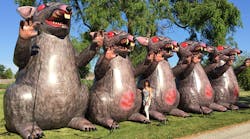If you haven’t seen him in real life, you’ve probably seen the photos of him presiding over union picket lines: a giant inflatable rat snarling, with teeth and claws bared to defend union members against unfair employers.
What you might not be aware of is that he has a name: Scabby the Rat, but if some localities and the National Labor Relations Board in particular have their say, he may go the way of the Dodo bird. It will still be possible to rent him for a children’s party, but only if you are the Addams family or just have some seriously weird children.
The unions don’t actually own the rats they deploy. They rent them from Big Sky, a balloon and searchlights company based in the Midwest, which offers the rampant rodents in a variety of different sizes and colors. They even offer a Donald Trump balloon depicting the President as a giant rat.
Before his most recent legal difficulties arose, Scabby had been ensnarled in litigation over the past 30-plus years, according to attorney Timothy C. Kamin of the law firm of Ogletree Deakins. Some challenges under federal labor law were brought by targeted employers who asserted displaying Scabby on job sites is unlawfully coercive toward secondary employers on the same site who are not involved in the union’s dispute.
There also have been First Amendment-based legal challenges brought by unions against efforts by local government units to rid their communities of rats and other signs and displays on public property and rights-of-way, for both safety and aesthetic reasons. This is where the most recent court case comes in.
In 2014, Laborers Union Local 330 chose to erect a 12-foot version of Scabby—it is said that other versions of him can grow to as much as 30 feet—on the median of a frontage road across from a car dealership in the town of Grand Chute, Wis., where a non-union masonry contractor was preforming construction work. The union also engaged in informational picketing at the site, asserting that the masonry contractor paid wages and benefits that were below area standards.
The town instructed the union to deflate the rat because it was in violation of its sign ordinance.
Last month, the Seventh Circuit U.S. Court of Appeals issued an opinion affirming the right of the town of Grand Chute to enforce its ordinance prohibiting such displays. The court rejected the union argument that the town had violated the union’s First Amendment rights.
In an earlier decision, the Seventh Circuit had agreed that the display of Scabby implicated First Amendment rights, but it also noted that a municipality may implement and enforce a nondiscriminatory ban of all private signs on public property and rights-of-way.
“Importantly, the court also noted that a facially lawful ordinance could result in First Amendment violations if it were enforced selectively, that is, if the municipality applies content-based discretion and permits certain messages while prohibiting others,” Kamin points out.
“Going forward, this ruling may enhance the confidence of local governments in enacting and enforcing such regulations, which do not target labor messages but rather seek to prevent ‘eyesores’ and structures that block traffic sightlines in general, regardless of their purpose or message.”
Of course, that won’t do you much good if you are an employer located in cities like New York, Chicago and Seattle, where the local governments are extremely union-friendly and unlikely to choose to enforce such statutes against the recalcitrant rodent, even if such signage laws already are on the books.
To obtain additional relief, employers soon may be able to turn to the NLRB. The Obama-era board held that the rats did not have an unlawful, coercive effect and likened the use of Scabby and his rat brothers and sisters to peaceful, protected activities such as hand-billing.
“Many employers dealing with inflatable rat displays would disagree, asserting that the rat is a coercive symbol that has the same purpose and effect as unlawful picketing,” Kamin says.
A recent news report revealed that current NLRB General Counsel Peter Robb has privately spoken of his personal hatred for poor Scabby. Whether that anonymous board source cited quoted Robb correctly or not, it is generally well known that Robb is looking for appropriate cases to bring before the current board with the goal of eventually limiting or eliminating the future use of Scabby by labor unions.




